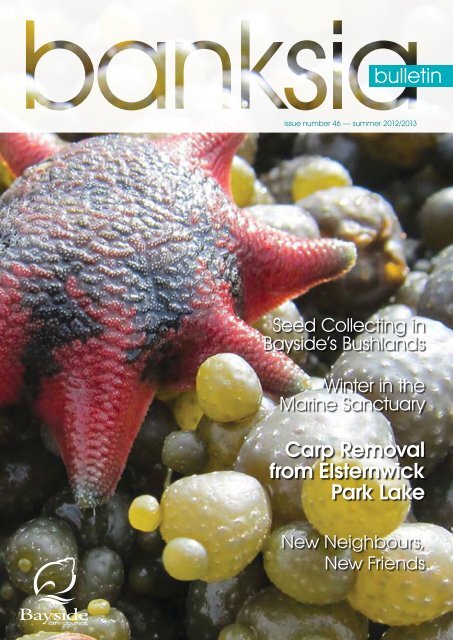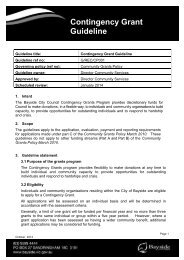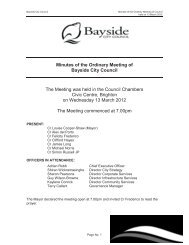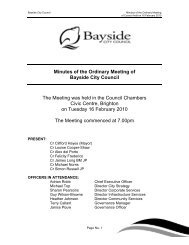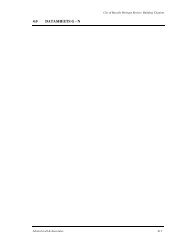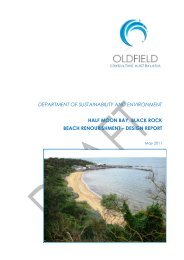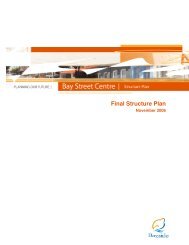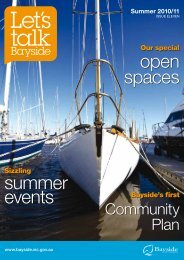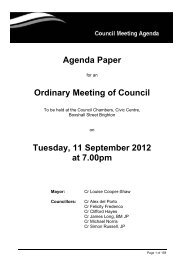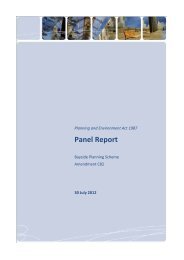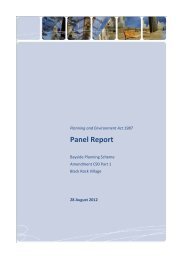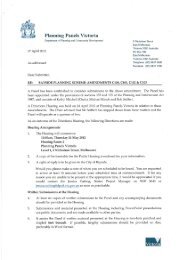Carp Removal from Elsternwick Park Lake - Bayside City Council
Carp Removal from Elsternwick Park Lake - Bayside City Council
Carp Removal from Elsternwick Park Lake - Bayside City Council
Create successful ePaper yourself
Turn your PDF publications into a flip-book with our unique Google optimized e-Paper software.
issue number 46 — summer 2012/2013<br />
Seed Collecting in<br />
<strong>Bayside</strong>’s Bushlands<br />
Winter in the<br />
Marine Sanctuary<br />
<strong>Carp</strong> <strong>Removal</strong><br />
<strong>from</strong> <strong>Elsternwick</strong><br />
<strong>Park</strong> <strong>Lake</strong><br />
New Neighbours,<br />
New Friends
2<br />
From the Mayor<br />
I am pleased to have this opportunity<br />
to make contact with readers of<br />
the Banksia Bulletin, which has long<br />
provided valuable information on<br />
<strong>Bayside</strong>’s natural environment.<br />
<strong>Bayside</strong>’s natural areas, such as the<br />
coast and inland bushland reserves<br />
are a vital part of our identity and are<br />
what makes living here so special.<br />
Having diverse natural areas so close<br />
to the city of Melbourne is a great<br />
privilege for local <strong>Bayside</strong> residents.<br />
These areas include the magnificent<br />
marine life found at the Ricketts<br />
Point Marine Sanctuary and the<br />
biodiversity rich inland heathlands.<br />
There are many values in having<br />
these areas so close to our homes.<br />
Not only are they a living museum of<br />
what this area was once like, they also<br />
provide us with the pleasures of nature<br />
based activities such as bushwalking,<br />
observing wildflowers and snorkelling.<br />
Importantly they are also a home and<br />
refuge to a range of native animals.<br />
To help you discover our natural<br />
coastal environment, <strong>Bayside</strong> <strong>City</strong><br />
<strong>Council</strong> is contributing to a “Summer<br />
by the Sea” educational program.<br />
This program will involve a range of<br />
outdoor activities that all can enjoy.<br />
Please read on to find out more.<br />
I wish all Banksia Bulletin readers<br />
an enjoyable and relaxing summer.<br />
Cr Stephen Hartney<br />
Mayor<br />
<strong>Bayside</strong> <strong>City</strong> <strong>Council</strong><br />
banksia bulletin — summer 2012/2013<br />
Front cover image<br />
Common Sea Star at Rickett’s<br />
Point. Photograph by Ray Lewis<br />
Back cover image<br />
Clematis microphyla<br />
by Pauline Reynolds
In this ISSUE<br />
Special features<br />
8<br />
10<br />
Program<br />
Liftout<br />
Seed Collecting in<br />
<strong>Bayside</strong> Bushlands<br />
Lara Nulty<br />
New Neighbours,<br />
New Friends<br />
Michael Norris<br />
17<br />
<strong>Carp</strong> <strong>Removal</strong><br />
<strong>from</strong> <strong>Elsternwick</strong><br />
<strong>Park</strong> <strong>Lake</strong><br />
in the<br />
Marine Sanctuary<br />
20Winter<br />
Ray Lewis<br />
banksia bulletin — summer 2012/2013<br />
Other articles<br />
Tree Controls in <strong>Bayside</strong>’s 4<br />
Residential Areas<br />
Friends of the Brighton Dunes 5<br />
Jenny Talbot<br />
Springtime Colours in the 6<br />
George Street Reserve<br />
Valerie Tarrant & Pauline Reynolds<br />
Family Life Open 7<br />
Garden Day<br />
Stephanie Werner<br />
Table Rock Planting Day 15<br />
Taliesin Galloway McLean<br />
Microbats in 16<br />
Cheltenham <strong>Park</strong><br />
Friends of Balcombe <strong>Park</strong> 18<br />
Joan Couzoff<br />
A Welcome Guest in 19<br />
My Garden<br />
Pauline Reynolds<br />
<strong>City</strong>wide New to the Crew 19<br />
Justin Gorwell<br />
Commotion in the 21<br />
Long Hollow Heathland<br />
Rob Saunders<br />
Working Bee Calendar 22<br />
3
4<br />
Tree Controls in <strong>Bayside</strong>’s<br />
Residential Areas<br />
The significance of trees and the tree canopy to neighbourhood<br />
character, landscape and broad community enjoyment is well<br />
recognised by the <strong>Bayside</strong> community. This is reflected in the existing<br />
planning policy and local law controls that apply across <strong>Bayside</strong>.<br />
The Draft Review of Vegetation Related Provisions in<br />
the <strong>City</strong> of <strong>Bayside</strong> (Sept 2011) has aimed to further<br />
develop and improve vegetation management within<br />
the residential areas of <strong>Bayside</strong> by setting out the<br />
current situation and identifying areas for improvement<br />
in <strong>Council</strong>’s policy, controls and processes.<br />
The draft review has been endorsed by <strong>Council</strong> and it<br />
is now the community’s opportunity to have a say by:<br />
• Making a submission to <strong>Council</strong>; and/or<br />
• Participating in a focus group.<br />
In order to assist you in making a submission, relevant<br />
explanatory information and a survey form are<br />
available <strong>from</strong>:<br />
• <strong>Council</strong>’s website at www.bayside.vic.gov.au/<br />
haveyoursay;<br />
banksia bulletin — summer 2012/2013<br />
• The <strong>Bayside</strong> Corporate Centre, 76 Royal Avenue,<br />
Sandringham; and<br />
• The <strong>Bayside</strong> Library branches (Beaumaris, Brighton,<br />
Hampton and Sandringham).<br />
<strong>Council</strong> is also organising three small focus group sessions<br />
to run in February 2013. The focus groups will enable<br />
interested community members to consider the review<br />
in much greater detail and provide direct feedback<br />
to <strong>Council</strong> officers and the consultants. Each session<br />
has 15 available spaces and bookings are essential.<br />
If you wish to register your interest in participating in<br />
a focus group discussion, please contact <strong>Council</strong>’s<br />
Urban Strategy team on (03) 9599 4444.<br />
Your feedback will help <strong>Council</strong> decide what to do<br />
next. Submissions close 5pm Friday 1 March 2013.
Friends of the Brighton Dunes<br />
It has been the loveliest spring I can remember since starting<br />
work in the Dr Jim Willis Reserve 18 years ago.<br />
The Coast Tea-tree (Leptospermum<br />
laevigatum) have been heavy<br />
with profuse white flowers, the<br />
Pomaderris (Pomaderris paniculosa)<br />
rich with fawn/pink and beige<br />
flowers, the Rhagodia (Rhagodia<br />
candolleana) rampant and the<br />
Clematis (Clematis microphylla) is<br />
flourishing – a veritable paradise!<br />
In early October we observed<br />
Superb Fairy Wrens, Pacific Gulls and<br />
Willy Wagtails, we also saw a kestrel<br />
flying over us. Our <strong>Bayside</strong> suburbs<br />
are where people want to live<br />
because of our lovely natural areas.<br />
It appears that meteorologists are<br />
optimistic about the weather. They<br />
say this summer will be ordinary<br />
as the strong La Nina event which<br />
brought us all the rain has ended<br />
and there is likely to be no shift back<br />
into El Nino. The dams that were<br />
64.6% full in November 2011 are<br />
81.5% full in 2012 (The Age, 13/11/12).<br />
The downside of such a wonderful<br />
clement spring is of course, the<br />
proliferation of weeds. We have<br />
pulled out lots of Pampas Lily of<br />
the Valley (Salpichroa origanifolia),<br />
one metre high Annual Veldt<br />
banksia bulletin — summer 2012/2013<br />
Grass (Ehrharta longiflora), and<br />
Galenia (Galenia pubescens).<br />
Many thanks to our volunteers and<br />
Liam Bucknell <strong>from</strong> <strong>City</strong>wide, and<br />
in particular to Jo Hurse who does<br />
such an outstanding job as leader<br />
of the <strong>City</strong>wide Bushland Crew.<br />
Jenny Talbot<br />
Coordinator<br />
Friends of the Brighton Dunes<br />
5
6<br />
Springtime Colours in the<br />
George Street Reserve<br />
The lovely bronze and gold of the Egg and Bacon Pea (Bossiaea cinerea)<br />
are at their best in late winter and early spring, bringing splendid colour to<br />
the heathlands. During these times, walkers along the track <strong>from</strong> the Big Heath,<br />
close to the Tulip Street entrance, will be rewarded if they continue through to<br />
the area most recently burned in a wildfire, as the Egg and Bacon is flowering<br />
prolifically on both sides of the path.<br />
Less spectacular than wildflowers, but worth a look, is<br />
the bracken growing thickly at the corner of George<br />
and Tulip Streets and near the sliprail. People sometimes<br />
ask if bracken is a native of Australia, and Austral Bracken<br />
(Pteridium esculentum) certainly is, and indigenous to<br />
<strong>Bayside</strong>. This plant grows well in dry soils and will tolerate<br />
salt-laden winds. As a child, I (Val) was told of its use for<br />
the relief of bull-ant bites and I remember grabbing a<br />
bunch of young fronds and rubbing them on to a nasty<br />
sting, with some benefit.<br />
Bracken was used by Aboriginal Victorians. ‘The Kulin<br />
people ate the rhizome after roasting it and beating<br />
it to a paste’.(Rob Scott et.al., Indigenous Plants of the<br />
Sandbelt, Earthcare, Melbourne, 2002).<br />
banksia bulletin — summer 2012/2013<br />
Outside the Reserve, an enthusiastic group of Friends<br />
and volunteers led by Pauline Reynolds worked on<br />
19 August to extend the plantings on the Tulip Street<br />
nature strip. This project is a great success and shows<br />
the diversity of flora which flourish in our local heathlands.<br />
At one point, a magpie with young flew over the workers<br />
– a reminder of the value of the Reserve as habitat for<br />
our fauna.<br />
Valerie Tarrant and Pauline Reynolds<br />
Joint Co-ordinators<br />
Friends of George Street Reserve
Family Life Open Garden Day<br />
Sunday 21 October 2012<br />
A wonderful community<br />
day was had by all<br />
who attended the<br />
annual Family Life<br />
Open Garden Day<br />
on Sunday 21 October.<br />
Close to 800 guests enjoyed<br />
wandering through six beautiful<br />
gardens and one intriguing driveway<br />
in Brighton. Over $35,000 was raised<br />
for Family Life’s important community<br />
strengthening services.<br />
<strong>Bayside</strong> <strong>City</strong> <strong>Council</strong> has been a<br />
major sponsor for many years, and<br />
was a major contributor to the success<br />
of the event. As well as sponsorship,<br />
<strong>Bayside</strong> <strong>City</strong> <strong>Council</strong> contributed on<br />
the day by operating a stall which<br />
provided information to guests about<br />
composting, sustainability and other<br />
environmental hints.<br />
Guests also enjoyed live music<br />
provided by local school groups<br />
and musicians, informative exhibits<br />
<strong>from</strong> nurseries and sponsors and<br />
the chance to view some fantastic<br />
sculptures by local artists.<br />
For many, a courtesy ride in one<br />
of the amazing vintage cars was<br />
a highlight. Guests were also able<br />
to enjoy the sausage sizzle or<br />
delicious Devonshire tea on offer.<br />
Run by a team of dedicated<br />
and hardworking volunteers, the<br />
Open Garden Day is an important<br />
fundraising event for Family Life.<br />
Family Life is a non-profit community<br />
organisation that helps local families<br />
by providing services such as<br />
counselling, support groups, training<br />
and community development in<br />
the Southern Metropolitan Region<br />
of Melbourne.<br />
Family Life would once again like<br />
to thank the sponsors, volunteers<br />
and the committee for organising<br />
and contributing to such a successful<br />
community event.<br />
Stephanie Werner<br />
Community Relations Officer<br />
Family Life<br />
All photographs by Pauline Reynolds<br />
banksia bulletin — summer 2012/2013<br />
Musicians <strong>from</strong> St Leonards entertaining visitors<br />
Henry, George and Paddy<br />
with their chooks<br />
7
8<br />
Seed Collecting in<br />
<strong>Bayside</strong>’s Bushlands<br />
It’s one of the first warm November days of the year and in many of the<br />
reserves around <strong>Bayside</strong> a sound vaguely reminiscent to the ‘popping’<br />
of popcorn can be heard.<br />
In actual fact, this is the sound of<br />
Showy Bossiaea’s (Bossiaea cinerea)<br />
pods bursting open with new seeds,<br />
and to the trained ears of <strong>City</strong>wide<br />
Horticulturalist Erika Anderson<br />
<strong>from</strong> <strong>Bayside</strong> Community Nursery<br />
it signifies the start of the seed<br />
collecting season.<br />
Every year the <strong>City</strong>wide bushland<br />
crew, along with the team <strong>from</strong><br />
<strong>Bayside</strong> Community Nursery and<br />
numerous volunteers, scour the<br />
reserves around <strong>Bayside</strong>, collecting<br />
the various seeds of wild grasses,<br />
ground-covers, shrubs and trees.<br />
They carefully collect and catalogue<br />
the seeds to ensure our indigenous<br />
flora has the best chance to flourish<br />
for generations to come.<br />
Those who take the time to appreciate<br />
the myriad of indigenous flora<br />
<strong>Bayside</strong> is laced with, have most<br />
likely, never given a thought to the<br />
maintenance and propagation<br />
of the plants and would take for<br />
granted that in some of the densely<br />
populated areas of Melbourne<br />
suburbia, Australian wildlife<br />
is prospering.<br />
The fact of the matter is that most<br />
of the indigenous plants found in<br />
abundance throughout <strong>Bayside</strong><br />
are a result of the hard work,<br />
banksia bulletin — summer 2012/2013<br />
determination, expertise and<br />
a little experimentation <strong>from</strong> the<br />
<strong>City</strong>wide <strong>Bayside</strong> horticultural teams<br />
and volunteers.<br />
Maintaining indigenous flora is<br />
a constant cycle that begins with<br />
collecting the native seeds at the<br />
start of a longer period of warmer<br />
weather. If the seeds haven’t<br />
opened, then various methods<br />
are used to encourage them and<br />
according to Erika, sometimes just<br />
leaving them in a paper bag on<br />
the dashboard of your car in the<br />
sun is enough.
This year, seed collecting started later<br />
than in previous years as a result of<br />
the drought finally breaking. Erika says<br />
it’s a sign the land is slowly reverting<br />
back to how it was in less droughtstricken<br />
times.<br />
“It’s really the heat that gets everything<br />
going,” says Erika. “In the past few<br />
years we have had to start collecting<br />
much earlier as the plants have been<br />
drying out and heating up quickly<br />
after winter. This year they have<br />
only just begun and it’s already<br />
mid-November”.<br />
After collection the seeds are planted<br />
and cultivated into the seedlings<br />
that are seen covering almost every<br />
surface in the <strong>Bayside</strong> Community<br />
Nursery come the start of the planting<br />
season in March. Different techniques<br />
are used to germinate the collected<br />
seeds. Most of Australia’s indigenous<br />
plants need heat to propagate and<br />
some are even reliant on bushfires.<br />
In special cases like Victoria’s floral<br />
emblem, the Common Heath<br />
(Epacris impressa), a bushfire is<br />
simulated through a special process<br />
of seed smoking in order to get the<br />
plant to germinate.<br />
Erika describes the Australian<br />
indigenous flora as “pretty incredible”<br />
and says that every year she looks<br />
forward to seeing the first of the<br />
wildflowers with excitement and a little<br />
apprehension of the huge task ahead.<br />
“The seed collecting is hard work but<br />
is really good fun once you get into it.<br />
You get to see your hard work literally<br />
grow before your eyes”.<br />
Lara Nulty<br />
Marketing Communications<br />
and CRM Co-ordinator<br />
<strong>City</strong>wide<br />
If you are interested in<br />
volunteering for <strong>Bayside</strong><br />
Community Nursery, please<br />
contact Erika Anderson on<br />
03 9583 8408<br />
banksia bulletin — summer 2012/2013<br />
Clematis microphylla<br />
Austrostipa mollis<br />
Austrodanthonia setacea var. setacea<br />
9
10<br />
New Neighbours,<br />
New Friends<br />
All the regulars at our monthly working bees live north of, or near, Bay Road<br />
Heathland Sanctuary. For the last few months we have been like house-proud<br />
gardeners, clearing overgrowth, planting for the coming year, tidying up for<br />
Spring Opening visitors, weeding, picking up litter and more weeding…<br />
The overgrowth was mainly Twiggy Daisy-bush (Oleria<br />
ramulosa) which has grown at the most recent<br />
ecological burn site. Removing its shade should enable<br />
the sun to stimulate a wider variety of plants. However<br />
this may turn out to be one of the patches where natural<br />
regeneration of heath is difficult. This is because it might<br />
have been affected by past human activities, like the<br />
scout camps, or simply left too long before being burnt.<br />
A student at the Australian Research Centre of Urban<br />
Ecology (ARCUE) studied the Sanctuary seed-banks and<br />
recommended burning all the land once every seven<br />
or so years to avoid losing species.<br />
For our planting sessions we were joined by people who<br />
the Friends of Native Wildlife had invited to “work, walk,<br />
and talk”. Most of the plants were propagated, by our<br />
wonderful Community Nursery <strong>from</strong> seed that we and<br />
others had collected <strong>from</strong> the Sanctuary. One exception<br />
was our State floral emblem, Common Heath (Epacris<br />
impressa). We have tried to grow it in the past but only<br />
one plant survived – and that was next door!<br />
banksia bulletin — summer 2012/2013<br />
“Next door” is behind us in the photo above in which<br />
we are collecting litter and weeding – mainly Panic<br />
Veldt-grass (Erharta erecta) – along the public walkway<br />
on “our” side of the fence. Soon that old factory building<br />
will be demolished to make way for the “Sandyhill”<br />
development with its 450 apartments. Following a<br />
successful campaign by the Friends in 2004/5 it will<br />
have special setbacks and lighting standards, and<br />
plants that are “complementary and compatible with<br />
the Heathland species”.<br />
Soon the people of Sandyhill and the ecology of the<br />
Sanctuary will become neighbours and, we hope, good<br />
neighbours. All will be very welcome to join us in caring<br />
for this wonderful refuge.<br />
Michael Norris<br />
Coordinator<br />
Friends of the Bay Road Heathland Sanctuary
BAYSIDE AREA ACTIVITIES GUIDE<br />
2 January to 27 January<br />
The Department of Sustainability<br />
and Environment’s annual<br />
festival for the Victorian coast<br />
Discover the wonders of <strong>Bayside</strong>’s<br />
special coast this summer.
Summer by the Sea hosts over 300 free family friendly,<br />
events along the beautiful Victorian coastline.<br />
Activities are fun, educational and explore the ecological diversity of Victoria’s coastal environments.<br />
Different activities are suitable for different age groups, with opportunities for both kids and<br />
adults to get involved. Take a tour of the dunes, learn how to stand up paddle board, join in<br />
a guided coastal walk or ride or go on a treasure hunt!<br />
CALEnDAR oF EVEnTS (BAySiDE AREA)<br />
Guided coastal walk<br />
Discover <strong>Bayside</strong>’s coastal flora<br />
and fauna on a guided walk<br />
towards Sandringham<br />
Date: Tuesday 8 January 2013<br />
Time: 9 – 11am<br />
Location: Meet at Love Street<br />
car park, Black Rock.<br />
Suitable for children<br />
and adults<br />
Bookings: Bookings essential.<br />
Phone Barbara Jakob<br />
on 0408 032 963 or email<br />
<strong>Bayside</strong>Friends@gmail.com<br />
Geology rocks<br />
Presentation and guided tour by<br />
Sandringham Foreshore Association<br />
about <strong>Bayside</strong>’s changing dunes,<br />
the summer/winter beaches, fossil<br />
discoveries, impacts of climate change<br />
and coastal processes.<br />
Date: Wednesday 16 January<br />
Time: 5:30 – 7pm<br />
Location: Brighton Life Saving Club,<br />
Esplanade, Brighton.<br />
Bookings: Bookings essential.<br />
Phone <strong>Bayside</strong> <strong>City</strong> <strong>Council</strong><br />
9599 4444 or email<br />
brighter@bayside.vic.gov.au<br />
Ride on the wild side<br />
Learn about local flora and fauna on<br />
a guided bike ride along <strong>Bayside</strong>’s<br />
foreshore towards Black Rock<br />
Date: Tuesday 8 January 2013<br />
Time: 9am – 12pm<br />
Location: Meet at car park<br />
opposite Trey Bit<br />
Reserve, Sandringham.<br />
Suitable for children<br />
and adults<br />
Bookings: Bookings essential.<br />
Phone Barbara Jakob<br />
on 0408 032 963 or email<br />
<strong>Bayside</strong>Friends@gmail.com<br />
Stand up paddle<br />
boarding<br />
Free 1 hour introductory stand up<br />
paddle boarding lesson<br />
Date: Friday 18 January 2013<br />
Time: 10am – 1pm<br />
Location: Meet at Sandy Beach<br />
HQ and kiosk Jetty Road,<br />
Sandringham.<br />
Suitable for 12 – 17<br />
year olds<br />
Bookings: Limited places.<br />
Bookings essential. Phone<br />
<strong>Bayside</strong> <strong>City</strong> <strong>Council</strong> 9599<br />
4444 or email<br />
brighter@bayside.vic.gov.au<br />
There is<br />
something for<br />
everyone with local<br />
activities supported<br />
by <strong>Bayside</strong> <strong>City</strong><br />
<strong>Council</strong>.<br />
Stand up paddle<br />
boarding<br />
Free 1 hour introductory stand<br />
up paddle boarding lesson<br />
Date: Friday 11 January 2013<br />
Time: 10am – 1pm<br />
Location: Meet at Sandy Beach HQ<br />
and kiosk Jetty Road,<br />
Sandringham.<br />
Suitable for 12 – 17<br />
year olds<br />
Bookings: Limited places.<br />
Bookings essential.<br />
Phone <strong>Bayside</strong> <strong>City</strong><br />
<strong>Council</strong> 9599 4444<br />
or email<br />
brighter@bayside.vic.gov.au<br />
Dog’s breakfast<br />
Breakfast for dogs and their owners<br />
Dates: Saturday 19 January 2013<br />
Time: 9am – 12pm<br />
Location: Sandringham Harbour,<br />
Jetty Road, Sandringham<br />
in front of Sandy HQ Kiosk<br />
Bookings: Bookings not required
KEy ACTiViTiES MAP<br />
Meeting points<br />
for activities:<br />
1<br />
2<br />
3<br />
4<br />
5<br />
Geology rocks<br />
Brighton Life Saving Club,<br />
Esplanade, Brighton<br />
Stand up paddle boarding<br />
Sandy Beach HQ and kiosk<br />
Jetty Road, Sandringham<br />
Dog’s breakfast<br />
Sandringham Harbour,<br />
Jetty Road, Sandringham<br />
Ride on the wild side<br />
Trey Bit Reserve, Sandringham<br />
Coastal walk<br />
Love Street car park, Black Rock<br />
Treasure hunt<br />
Donald MacDonald Reserve,<br />
Beaumaris<br />
Junior ranger<br />
Ricketts Point Tea House Gardens<br />
Guided coastal walk<br />
Discover <strong>Bayside</strong>’s coastal flora<br />
and fauna on a guided walk<br />
towards Beaumaris<br />
Date: Sunday 20 January 2013<br />
Time: 9 – 11am<br />
Location: Meet at Love Street<br />
car park, Black Rock.<br />
Suitable for children<br />
and adults<br />
Bookings: Bookings essential.<br />
Phone Barbara Jakob on<br />
0408 032 963 or email<br />
<strong>Bayside</strong>Friends@gmail.com<br />
Junior ranger: mud<br />
pies and other sandy<br />
adventures<br />
Date: Tuesday 22 January 2013<br />
Time: 9:30 – 11:30am<br />
Location: Meet at Ricketts Point<br />
Tea House Gardens<br />
Bookings: Bookings essential.<br />
Phone Barbara Jakob<br />
on 0408 032 963 or email<br />
<strong>Bayside</strong>Friends@gmail.com<br />
1<br />
2<br />
DENDY ST<br />
HAMPTON ST<br />
BEACH RD<br />
PORT<br />
PHILLIP BAY<br />
SOUTH RD<br />
BAY RD<br />
3<br />
4<br />
5<br />
RESERVE RD<br />
Ride on the wild side<br />
Learn about local flora and fauna on<br />
a guided bike ride along <strong>Bayside</strong>’s<br />
foreshore towards Black Rock<br />
Learn about local flora and fauna<br />
Date: Sunday 20 January 2013<br />
Time: 9am – 12pm<br />
Location: Meet at car park<br />
opposite Trey Bit Reserve,<br />
Sandringham.<br />
Suitable for children<br />
and adults<br />
Bookings: Bookings essential.<br />
Phone Barbara Jakob<br />
on 0408 032 963 or email<br />
<strong>Bayside</strong>Friends@gmail.com<br />
Modern treasure hunt<br />
Join in a modern treasure hunt<br />
(geocaching) with GPS supplied<br />
Date: Sunday 27 January<br />
Time: 6 – 8pm<br />
Location: Meet at Donald MacDonald<br />
Reserve playground, Cnr<br />
Keating and Stawell St,<br />
Beaumaris.<br />
Suitable for children<br />
8yrs + with a parent<br />
Bookings: Bookings essential.<br />
Phone Barbara Jakob<br />
on 0408 032 963 or email<br />
<strong>Bayside</strong>Friends@gmail.com<br />
NEPEAN HIGHWAY<br />
BALCOMBE RD<br />
BEAUMARIS<br />
BAY<br />
2 January to 27 January<br />
WARRIGAL RD<br />
Modern treasure hunt<br />
Join in a modern treasure hunt<br />
(geocaching) with GPS supplied<br />
Date: Tuesday 22 January<br />
Time: 6 – 8pm<br />
Location: Meet at Donald MacDonald<br />
Reserve playground,<br />
Cnr Keating and Stawell St,<br />
Beaumaris.<br />
Suitable for children<br />
8yrs + with a parent<br />
Bookings: Bookings essential.<br />
Phone Barbara Jakob<br />
on 0408 032 963 or email<br />
<strong>Bayside</strong>Friends@gmail.com<br />
For more information<br />
and a copy of the full<br />
program guide, please visit<br />
the Summer by the Sea<br />
website at www.dse.vic.<br />
gov.au/summerbythesea<br />
Summer by the Sea is an initiative of the Department of Sustainability and Environment and <strong>Park</strong>s Victoria with local activities supported by <strong>Bayside</strong> <strong>City</strong> <strong>Council</strong>.
Conserve our Coasts<br />
Throughout the world’s<br />
oceans lurks a silent killer.<br />
It will outlive us, outswim us,<br />
and threatens to undo us.<br />
Sharks and sea snakes are<br />
minnows by comparison.<br />
Box jellyfish and blue ring<br />
octopus don’t even rate.<br />
The predator is plastic<br />
and it’s floating in an<br />
ocean near you.<br />
For further information visit<br />
www.bayside.vic.gov.au/summerbythesea<br />
2 January to 27 January<br />
What’s at stake?<br />
Around one million seabirds and 100,000 marine mammals<br />
are killed every year by this silent killer.<br />
Plastics enter the bottom of the food chain through<br />
zooplankton, which confuse their regular prey for tiny<br />
plastic pieces.<br />
An estimated 1500 seals and sea lions become tangled<br />
in marine debris and die every year in southern Australia.<br />
Unlike naturally-based paper or glass, plastic never truly<br />
goes away; it just breaks down into smaller pieces.<br />
That means that every piece of plastic you and i have<br />
ever used is still around today.<br />
This is a global problem, with a truly local solution. We can<br />
turn our plastic addiction around. We can spread the word,<br />
change our habits, break the deadly cycle and save our<br />
marine life.<br />
Here are a couple of tips to get your started.<br />
• Reduce your use of disposable, single-use,<br />
unnecessary items.<br />
• Say no to bottled water!<br />
• Stop using plastic bags! Buy a reusable bag<br />
and keep it with you.<br />
Source: Australian Marine Conservation Society
Table Rock Planting Day<br />
A while ago now, on Sunday 24 June, lots of <strong>Bayside</strong> families met up for a<br />
special tree planting working bee at Table Rock, Beaumaris, to help save our<br />
environment. The day was organized by <strong>City</strong>wide Open Space, Enviro Kids,<br />
the <strong>Bayside</strong> Environment Friends Network, the Beaumaris Conservation Society<br />
and the Beaumaris Sea Scouts.<br />
This day was lots of fun. There were hundreds of tiny seedlings planted all over the foreshore reserve. We put on our<br />
gardening gloves, picked up a trowel and started digging holes. To help take care of the plants, we had to insert<br />
a little bit of special gel into each hole before putting in the plants – this will help to keep moisture around the plant<br />
roots while they are growing, (this was one of the most fun parts!). Digging the holes was a bit tiring, but fortunately,<br />
to help speed up the process a special hole-making tool was used.<br />
We planted seedlings all over all the<br />
reserve, but my favourite place to<br />
work was near the edge of the cliff,<br />
because there were spectacular<br />
views over the bay.<br />
All together, the volunteers planted<br />
650 plants in just under 1.5 hrs. It<br />
looked so fantastic when we had<br />
finished! We planted a variety<br />
of indigenous plants that are<br />
specialized to cope with the salty<br />
and windy conditions in the area.<br />
The species included:<br />
• Bower Spinach<br />
(Tetragonia implexicoma)<br />
• Seaberry Saltbush<br />
(Rhagodia candolleana)<br />
• Tea Tree<br />
(Leptospermum laevigatum)<br />
• Boobialla (Myoporum insulare)<br />
• Matt Rush (Lomandra spp.)<br />
• Kidney Weed<br />
(Dichondra repens)<br />
Michael Norris inspecting the work of budding young naturalists at Table Rock<br />
banksia bulletin — summer 2012/2013<br />
• Wallaby Grass<br />
(Austrodanthonia caespitosa)<br />
• Spear Grass (Austrostipa mollis)<br />
The hard workers were rewarded with<br />
a BBQ afterwards. Now we are all<br />
looking forward to the next working<br />
bee, when more <strong>Bayside</strong> families<br />
will return and help weed the area<br />
to keep the seedlings healthy. I hope<br />
you can come too!<br />
Taliesin Galloway McLean<br />
Environment Captain,<br />
Sandringham House Primary School<br />
15
16<br />
Close up of a Gould’s Wattled Bat<br />
Close up of a Gould’s Wattled Bat<br />
Upcoming Event<br />
Microbats at Cheltenham <strong>Park</strong><br />
Microbats range <strong>from</strong> the size of a moth to a hand,<br />
and live off mosquitoes and other insects.<br />
These tiny, not to mention interesting<br />
looking creatures are extremely<br />
important for the liveability of our<br />
neighbourhoods, eating up to 600<br />
mosquitoes an hour!<br />
Melbourne University with the <strong>Bayside</strong><br />
Environment Friends Network and<br />
Friends of Native Wildlife are inviting<br />
you to become a bat detector for an<br />
evening in the name of conservation.<br />
<strong>Bayside</strong> Environment Friends Network<br />
Are you interested in native plants and animals?<br />
Do you have a passion for the environment?<br />
Then the <strong>Bayside</strong> Environment Friends Network may be just for you!<br />
Members of <strong>Bayside</strong>’s 17 Friends groups and others interested in the<br />
natural environment of <strong>Bayside</strong> meet regularly to discuss their latest<br />
projects and other environmental issues.<br />
Enviro Kids<br />
Mums, Dads and Kids!<br />
Come along and discover the magic of <strong>Bayside</strong>’s<br />
bushlands and learn about your local environment.<br />
Enviro Kids is a fun activities-based environmental playgroup in <strong>Bayside</strong><br />
coordinated by Barbara Jakob of the <strong>Bayside</strong> Environmental Friends Network.<br />
Activities have been developed by Barbara and qualified teachers.<br />
Children <strong>from</strong> three to five years, with their carers meet monthly in one of<br />
<strong>Bayside</strong>’s beautiful bushland or foreshore reserves to discover and appreciate<br />
their local environment through play.<br />
For more information contact Barbara Jakob at baysidefriends@gmail.com<br />
banksia bulletin — summer 2012/2013<br />
Participants will conduct night surveys<br />
searching for and trapping bats.<br />
You will discover microbat habitats,<br />
nesting locations and learn about<br />
the threats facing microbats.<br />
When?<br />
Saturday, 2 March 2013<br />
Enviro Kids session <strong>from</strong> 5-7pm and<br />
all are welcome <strong>from</strong> 6pm onwards<br />
to help set up traps throughout the<br />
park. An information session will begin<br />
at 7.30pm with a BBQ.<br />
Where?<br />
Cheltenham <strong>Park</strong><br />
Melway Reference 86 G1<br />
Meet at the BBQ area near the<br />
scouts hall off <strong>Park</strong> Rd, Cheltenham<br />
Cost?<br />
Free!<br />
Contact<br />
Please RSVP to attend<br />
Barbara Jakob<br />
Coordinator – <strong>Bayside</strong> Environment<br />
Friends Network<br />
baysidefriends@gmail.com<br />
Mob: 0408 032 963<br />
Meeting Times<br />
25 February 2013<br />
25 March 2013<br />
29 April 2013<br />
27 May 2013<br />
4.30-6.00pm<br />
Beaumaris Senior Citizen Centre<br />
Reserve Road, Beaumaris<br />
Meeting Times<br />
2 March 2013 (Bat Event)<br />
24 March 2013<br />
28 April 2013<br />
26 May 2013<br />
9.30-11.30am at various locations<br />
with the exception of the bat event.<br />
* A small fee of up to $7 may<br />
be applicable for some events<br />
to assist with the payment<br />
of materials.
Fishing at <strong>Elsternwick</strong> <strong>Park</strong> <strong>Lake</strong><br />
<strong>Carp</strong>e Diem<br />
<strong>Bayside</strong> <strong>City</strong> <strong>Council</strong> Seize the Opportunity to Remove European <strong>Carp</strong><br />
<strong>from</strong> <strong>Elsternwick</strong> <strong>Park</strong> <strong>Lake</strong><br />
<strong>Elsternwick</strong> and Elwood <strong>Park</strong>s are<br />
frequented by large numbers of<br />
people for sporting and recreational<br />
activities. To improve water availability<br />
for irrigating the parks, <strong>Bayside</strong> <strong>City</strong><br />
<strong>Council</strong> and Port Phillip <strong>Council</strong><br />
have teamed up to undertake<br />
a project to harvest stormwater<br />
<strong>from</strong> the Elster Creek Drain.<br />
This project involves diverting a<br />
small percentage of the flow in the<br />
Elster Creek Drain into a treatment<br />
wetland located on the <strong>Elsternwick</strong><br />
Golf Course. This treated water<br />
will then be transferred into the<br />
existing lake in the southern area of<br />
<strong>Elsternwick</strong> <strong>Park</strong>. From here it will be<br />
distributed to nearby recreational<br />
and sporting facilities for irrigation.<br />
To prepare the <strong>Elsternwick</strong> <strong>Park</strong> <strong>Lake</strong><br />
to become a storage facility, it has<br />
been drained. While this drainage<br />
was occurring, <strong>Bayside</strong> <strong>City</strong> <strong>Council</strong>’s<br />
Open Space team saw a golden<br />
opportunity to try and rid the lake<br />
of European <strong>Carp</strong> (Cyprinus carpio)<br />
which is known to be present there.<br />
European <strong>Carp</strong> is an introduced<br />
pest species and now one of the<br />
most abundant large freshwater<br />
fish in water bodies throughout<br />
south-eastern Australia. Thanks<br />
to their breeding habits and<br />
resilience, carp could eventually<br />
become widespread throughout<br />
the country. They have a wide<br />
range of detrimental impacts on<br />
natural ecosystems, such as:<br />
• Reducing water quality through<br />
uprooting vegetation and stirring<br />
up sediments during feeding<br />
• Eroding of river and<br />
lake banks due to their<br />
destructive feeding habits<br />
• Reducing native fish<br />
populations through increased<br />
competition for resources<br />
Around this time of year the carp in<br />
<strong>Elsternwick</strong> <strong>Park</strong> <strong>Lake</strong> lay their eggs in<br />
the reeds and vegetation fringing it.<br />
By lowering the level of the lake for<br />
the stormwater harvesting project, the<br />
eggs have been exposed to the air<br />
and dried out. This will ensure that a<br />
banksia bulletin — summer 2012/2013<br />
large percentage of the future carp<br />
population has been eradicated.<br />
To remove the existing adults<br />
and juveniles <strong>from</strong> the lake, two<br />
qualified carp fisherman ran nets<br />
around the lake on 23 November.<br />
The total catch for the day was:<br />
• 260 <strong>Carp</strong> (360 kg)<br />
• 2 skateboards<br />
• 1 engine block<br />
• 4 cricket balls<br />
Rather than simply turning the<br />
removed carp into fertiliser, they<br />
can be processed in a number of<br />
innovative ways. Fresh whole carp<br />
and fillets are sold for domestic and<br />
international consumption. In the<br />
Czech Republic carp is a traditional<br />
Christmas food and is eaten in a<br />
number of different ways. The skin<br />
of the carp will be used for leather<br />
and scales in the production of paint.<br />
While some carp remain in the lake,<br />
their numbers have been reduced.<br />
This will hopefully improve the quality<br />
of the lake for native wildlife.<br />
17
18<br />
The “Clematis Elephant” by Pauline Reynolds<br />
Friends of<br />
Balcombe <strong>Park</strong><br />
Good winter rains meant that<br />
Balcombe <strong>Park</strong> became an<br />
amazing sea of flowering native<br />
plants this spring.<br />
An elephant even came to visit us! Well, not really, it<br />
was actually a Clematis (Clematis microphylla) in full<br />
flower covering an old tree which we think looked just<br />
like an elephant.<br />
During spring, orchids were also abundant, especially<br />
greenhoods and maroon hoods. Balcombe <strong>Park</strong> is<br />
also known for its fungi and a coral fungi was found<br />
this year in the site of the 2008 ecological burn.<br />
Joan Couzoff<br />
Coordinator<br />
Friends of Balcombe <strong>Park</strong><br />
Coral fungi by Jane Hart<br />
banksia bulletin — summer 2012/2013
Eastern Rosella by Pauline Reynolds<br />
A Welcome<br />
Guest in my<br />
Garden<br />
Sometimes an Eastern Rosella appears<br />
in my garden. One spring day the<br />
beautiful male bird in the photo visited<br />
for nearly the whole morning feasting<br />
on all the goodies he could find.<br />
I was lucky to get this picture as he was too far away<br />
<strong>from</strong> me most of the time, but suddenly came quite<br />
close to my back door where I was able to take a<br />
couple of photographs before he flew away.<br />
Completely by chance of course he sat where the<br />
picture also contains, in the background, two pottery<br />
birds, “Bronzewings”, sculpted by Carmen Skrobonja.<br />
Carmen managed the <strong>Bayside</strong> Community Plant<br />
Nursery until last year when illness forced her into a<br />
prolonged absence. When able she creates some<br />
amazing pieces. I had the opportunity to purchase<br />
a few which look beautiful in the garden.<br />
Pauline Reynolds<br />
banksia bulletin — summer 2012/2013<br />
<strong>City</strong>wide New<br />
to the Crew<br />
Recent university graduate<br />
Justin Gorwell is new to<br />
<strong>City</strong>wide’s bushland crew.<br />
Before commencing work at <strong>Bayside</strong> I studied<br />
Conservation Biology and Ecology at La Trobe<br />
University. From this degree I grew a passion for<br />
the natural Australian environment and knew that<br />
I wanted a career working in this field.<br />
I joined the <strong>City</strong>wide Bushland Crew about six months<br />
ago and was given the role of looking after three<br />
of the inland Heathland areas, Donald Macdonald<br />
Reserve, George St Heathland and Woodland<br />
Reserve and Gramatan Avenue Heathland Sanctuary.<br />
Very quickly I realised this job was exactly what I<br />
wanted, one where I could use my passion for the<br />
Australian environment whilst building a career.<br />
Since working at <strong>Bayside</strong> I have grown a greater<br />
appreciation for the diversity of native plants<br />
found within the heathlands and especially in the<br />
ecologically burnt areas. The richness of species<br />
and even just the aesthetic beauty of these burnt<br />
areas is so much greater than that of the nonburnt<br />
areas. Many of the species found in the<br />
burn sites such as Small Grass-tree (Xanthorrea<br />
minor) or Wedding Bush (Ricinocarpus pinifolius)<br />
are nowhere near as abundant in the non-burnt<br />
areas. This highlights how important ecological<br />
burning is within these vegetation communities.<br />
The wildlife found in the Heathland areas is also<br />
quite amazing. I have spotted many interesting bird<br />
species since working<br />
here such as a Southern<br />
Boobook and Eastern<br />
Spinebills. I look forward<br />
to continuing to work in<br />
the heathland areas.<br />
Justin Gorwell<br />
Bushland Crew #1<br />
<strong>City</strong>wide Open Space<br />
Justin Gorwell<br />
19
20<br />
Crustacean fossil by Ray Lewis Mouth of Toad Fish by Ray Lewis<br />
Square Biscuit Star by Tim Forster Tuskworm cone by Terry Valentine<br />
Winter in the Marine Sanctuary<br />
At Marine Care Ricketts Point, we have begun to take our nature observations<br />
and in particular underwater photography, to a new level. We are now so<br />
familiar with life underwater that anything out of the ordinary attracts our<br />
attention. That goes for water birds too.<br />
Also, we are now well underway doing local water testing,<br />
which should be of general benefit as we come to grips<br />
with the water quality throughout the year and develop<br />
local ground rules for when it’s safe or not safe to dive.<br />
Marine Care membership numbers are strong at<br />
around 120, and our recent winter events including<br />
a walk through the Williamstown wetlands, our Annual<br />
Winter Solstice walk, and a special bayside marine<br />
banksia bulletin — summer 2012/2013<br />
groups ‘Ngargee’ event (Boon wurrung for parley, dance,<br />
etc) at the Beaumaris Yacht Club were all successes. The<br />
Ngargee in particular, showed us all that everyone who<br />
is associated with the Bay <strong>from</strong> painters through to dog<br />
walkers, fishermen and divers, all speak with a common<br />
voice when it comes to protecting this most splendid<br />
asset we enjoy.<br />
Ray Lewis
Commotion in the Long<br />
Hollow Heathland<br />
On 26 August 2012, during the Long Hollow Heathland working bee,<br />
the Friends heard quite a commotion amongst the small birds that call<br />
the Heathland home.<br />
These birds included a White-eared Honeyeater<br />
and several Pardalotes. Searching for the source of<br />
the commotion, we saw the smaller birds chasing a<br />
female Fan-tailed Cuckoo (Cacomantis flabelliformis)<br />
with its distinctive barred, wedge-shaped tail and<br />
yellow eye-ring.<br />
Fan-tailed Cuckoos are a relatively common species<br />
in eastern Australia, but are rarely seen in <strong>Bayside</strong>. They<br />
are known as “brood parasites” which means they lay<br />
their eggs in the nests of other bird species. Cuckoos will<br />
commonly remove an egg <strong>from</strong> the nest of another bird<br />
species and lay one of their own in its place. There are<br />
remarkable similarities in the markings of the cuckoo’s<br />
egg and that of the host species. Unaware of this switch,<br />
banksia bulletin — summer 2012/2013<br />
the host parents will continue to incubate their eggs and<br />
that of the Cuckoo. The young Cuckoo generally hatches<br />
earliest and proceeds to eject the host’s other eggs or<br />
hatchlings <strong>from</strong> the nest. The new parents are then left<br />
to rear a single Cuckoo chick which often grows to be<br />
much larger than the parents themselves.<br />
It may have been that the Cuckoo in Long Hollow was<br />
looking for a host nest. However the other birds made<br />
sure it only stayed around for 10 minutes before being<br />
harassed off the premises.<br />
Rob Saunders<br />
Friends of Long Hollow Heathland<br />
21
22<br />
Working Bee Calendar<br />
FRIENDS/ ENVIRO GROUPS<br />
MELWAY<br />
REF<br />
Friends of Balcombe <strong>Park</strong> 86 C4<br />
Friends of Bay Rd 77 B11<br />
<strong>Bayside</strong> Environmental<br />
Friends Network<br />
<strong>Bayside</strong> Bushwalking Club<br />
(Charman to Cromer Rds, Beaumaris)<br />
<strong>Bayside</strong> Community Nursery 77 D12<br />
Beaumaris Conservation Society<br />
Black Rock and Sandringham<br />
Conservation Association<br />
Friends of Brighton Dunes 76 C2<br />
Friends of Cheltenham <strong>Park</strong> 86 G1<br />
Cheltenham Primary<br />
School Sanctuary<br />
Friends of Donald<br />
MacDonald Reserve<br />
Enviro Kids<br />
86 B6<br />
Friends of George Street Reserve 86 B1<br />
Friends of Gramatan Avenue<br />
Heathland<br />
86 C6<br />
Friends of Long Hollow Heathland 86 D5<br />
Friends of Merindah <strong>Park</strong> &<br />
Urban Forest<br />
77 B12<br />
CONTACT DETAILS<br />
Coordinator: Joan Couzoff<br />
Phone: (03) 9589 1060<br />
Coordinator: Michael Norris<br />
Phone: (03) 9521 0804 Email: menorris@ozemail.com.au<br />
Coordinator: Barbara Jakob<br />
Mobile: 0408 032 963 Email: baysidefriends@gmail.com<br />
Contact: Jo Hurse<br />
(<strong>City</strong>wide) 9283 2052<br />
Contact: Erika Anderson<br />
319 Reserve Road, Cheltenham 3192<br />
Phone: (03) 9583 8408 Open Thurs and Sat 10am – 12pm<br />
President: Chris Sutton<br />
PO Box 7016, Beaumaris 3193 Email: ggd@netspace.net.au<br />
Coordinator: Bob Whiteway Phone: (03) 9502 0060 Email: bobwhiteway@optusnet.com.au<br />
Co-ordinator: Jenny Talbot<br />
Phone: (03) 9592 2109<br />
Co-ordinator: Elizabeth McQuire<br />
Phone: (03) 9592 6474<br />
Coordinator: Valerie Tyers<br />
Phone: (03) 9588 0107 Email: valerietyers@hotmail.com<br />
Contact: Marg McIntosh<br />
Phone: (03) 9583 1614 Email: mcintosh.margaret.h@edumail.vic.gov.au<br />
Coordinator: Kim Croker<br />
Phone: (03) 9589 2443 Email: kcroker@bigpond.net.au<br />
Enquiries to Barbara Jakob Phone: 0408 032 963<br />
Coordinator: Val Tarrant<br />
Phone: (03) 9598 0554 Email: vtarrant@ozemail.com.au.<br />
Coordinator: Pauline Reynolds<br />
Phone: (03) 9598 6368 Email: pauline.reynolds@bigpond.com<br />
Coordinator: Ken Rendell<br />
Phone: (03) 9589 4452<br />
Coordinator: Ken Rendell<br />
Phone: (03) 9589 4452<br />
Marine Care Ricketts Point Inc 86 C9 Phone: (03) 9589 4452<br />
Friends of Native Wildlife<br />
NED (New Environment Directions)<br />
at <strong>Elsternwick</strong> <strong>Park</strong><br />
Friends of Ricketts Point Landside 86 C9<br />
St. Leonards College<br />
Conservation Group<br />
Friends of Table Rock 86 E10<br />
Friends of Watkins Bay 86 D9<br />
Coordinator: David Cockburn<br />
Phone: (03) 9598 6148 Email: davidcoc@optusnet.com.au<br />
Coordinator: Michael Norris<br />
Phone: (03) 9521 0804 Email: menorris@ozemail.com.au<br />
Coordinator: Neil Blake, Port Phillip EcoCentre<br />
Phone: (03) 9534 0413 Email: neilblake.ecocentre@iinet.net.au<br />
Coordinator: Sue Raverty<br />
Phone: (03) 9589 2103<br />
Email: sraverty@westnet.com.au<br />
Contact: Luisa Ingram<br />
Phone: (03) 9909 9300 Email: Luisa.Ingram@stleonards.vic.edu.au<br />
Coordinator: Ken Rendell<br />
Phone: (03) 9589 4452<br />
Coordinator: Moira Longden<br />
Phone: (03) 9589 2725<br />
banksia bulletin — summer 2012/2013
January 2013 to March 2013<br />
TIME JANUARY FEBRUARY MARCH<br />
10am – noon 27 24 31<br />
10am – noon 12 9 9<br />
4.30 – 6.00pm 25 24<br />
Contact Jo Hurse<br />
(<strong>City</strong>wide) 9283 2052<br />
10am – noon<br />
10am – noon 15 5, 19 5, 19<br />
8am – 10am 8, 15, 22, 29 5, 12, 19, 26 5, 12, 19, 26<br />
10am – noon 3 3<br />
9am – noon<br />
Contact School 9583 1614<br />
16 17<br />
10am – noon 3 3<br />
9.30am-11.30am 2, 24<br />
10am – noon 20 17 17<br />
1pm – 3pm 3 3<br />
1pm – 3pm 27 24 24<br />
10am – noon<br />
9.30am<br />
1.00pm – 3.00pm 15 19 19<br />
12.30pm – 2.30pm 29 26 26<br />
10am – noon 30 27 27<br />
banksia bulletin — summer 2012/2013<br />
Editorial Policy<br />
The purpose of publishing the Banksia<br />
Bulletin is to circulate information, report on<br />
events, and to profile relevant environmental<br />
issues important to our community. The<br />
Bulletin is also published to support the<br />
network of people involved in enjoying<br />
and protecting our local environment.<br />
<strong>Bayside</strong> <strong>City</strong> <strong>Council</strong> encourages people<br />
<strong>from</strong> our local community groups to submit<br />
articles of interest, share experiences and<br />
news about any upcoming events. All articles<br />
are reviewed prior to publication and <strong>Council</strong><br />
reserves the right to omit or edit submissions.<br />
Acknowledgements<br />
Thank you to all the people who have<br />
contributed to this issue of Banksia Bulletin.<br />
Disclaimer<br />
The views expressed in the Banksia Bulletin<br />
are not necessarily those of <strong>Bayside</strong> <strong>City</strong><br />
<strong>Council</strong> nor its representatives.<br />
Editor<br />
Simon Finlay, Acting Manager<br />
Environmental Sustainability & Open Space.<br />
Copy deadlines 2013<br />
Copy deadlines are set for the first<br />
Friday of the month of release:<br />
Autumn 2013<br />
1 March for release end March.<br />
Winter 2013<br />
7 June for release end June.<br />
Banksia Bulletin is published quarterly by<br />
<strong>Bayside</strong> <strong>City</strong> <strong>Council</strong> to service people<br />
interested in enjoying and protecting the<br />
local environment.<br />
If you would like to be added to the Banksia<br />
Bulletin mailing list, please contact <strong>Bayside</strong><br />
<strong>City</strong> <strong>Council</strong> on 9599 4444 or email:<br />
banksia@bayside.vic.gov.au<br />
Please indicate whether you would<br />
prefer to receive your Banksia Bulletin<br />
by post or via email.<br />
Corporate Centre<br />
PO Box 27 Royal Avenue<br />
SANDRINGHAM VIC 3191<br />
Telephone: 9599 4444<br />
www.bayside.vic.gov.au<br />
banksia@bayside.vic.gov.au<br />
Hours of business<br />
8.30am – 5pm<br />
Monday – Friday<br />
(except public holidays)<br />
23
24<br />
banksia bulletin — summer 2012/2013<br />
Do you want to know more<br />
about <strong>Bayside</strong> and the<br />
Banksia Bulletin?<br />
Please refer to our website<br />
www.bayside.vic.gov.au


